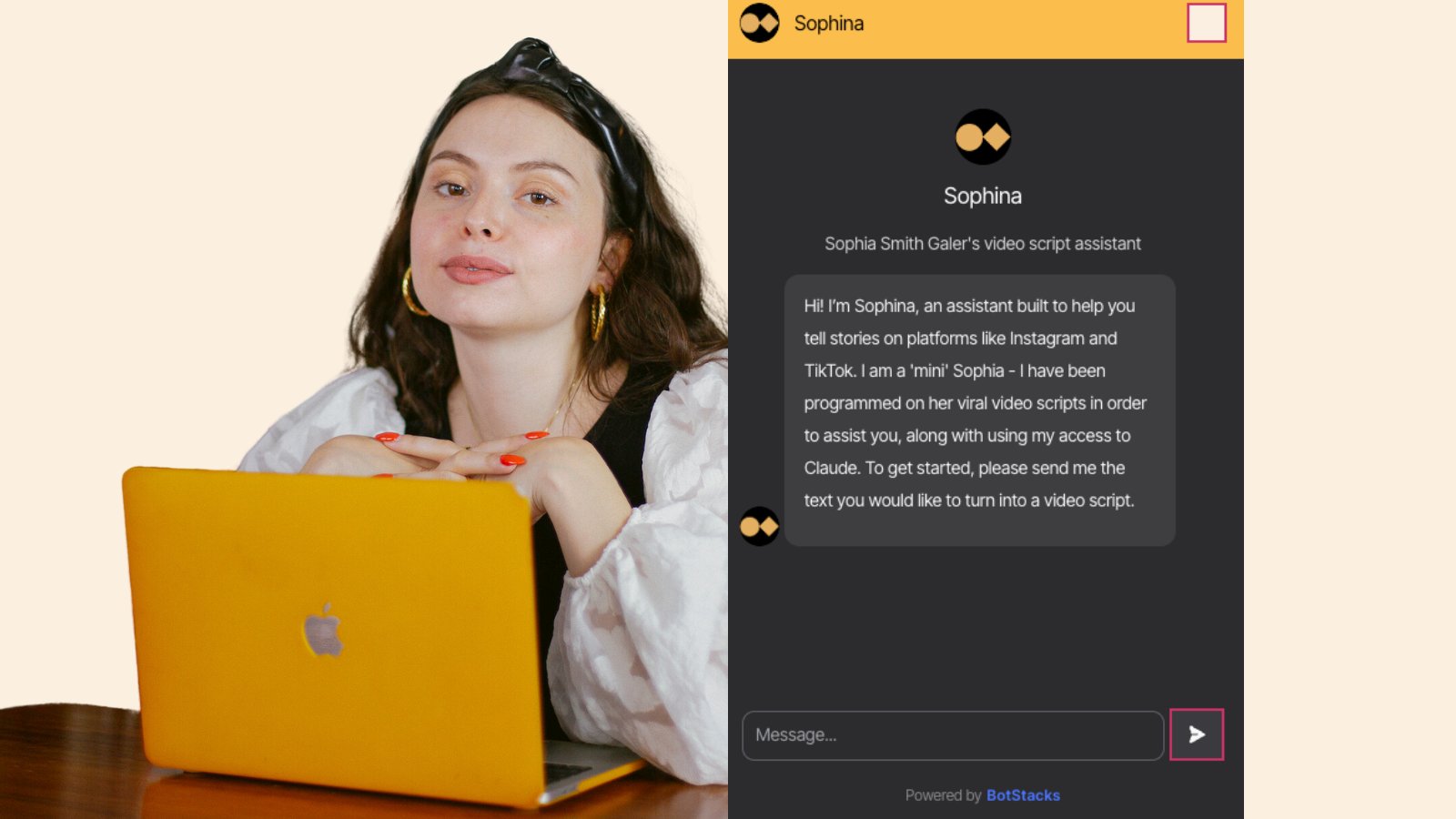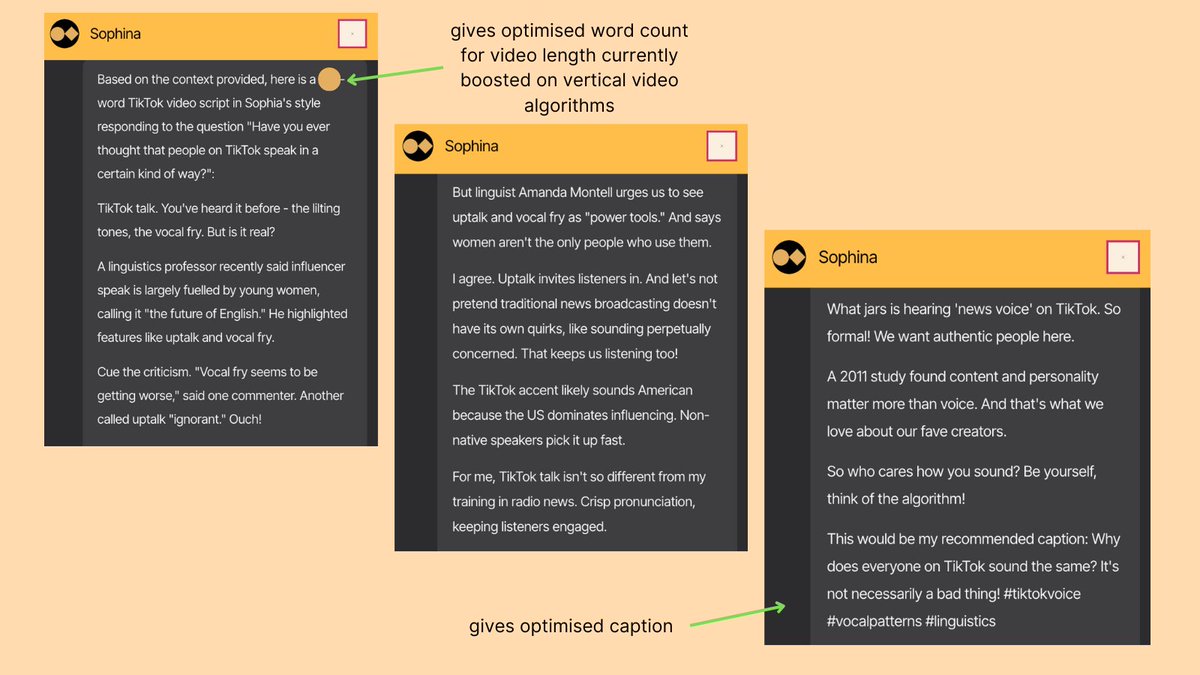I trained an AI model with my own scripts and created a chatbot to help journalists make viral vertical videos

Sophia Smith Galer and her chatbot Sophina. Courtesy: Sophia Smith Galer.
1. The project in a nutshell
I wanted to build a chatbot that could help people make vertical videos in my style – the kind of explainers that I’ve been delivering since 2019 which have won me over 160 million views on TikTok and Instagram Reels. That’s why she’s called Sophina, literally ‘little Sophia’; it’s like having me in your back pocket, giving you video advice.
Sophina is a script assistant. You can use it to rapidly refashion work you’ve already done – a news article, an academic paper, a company report – into a script optimised for going viral.
2. The problem I wanted to solve
There were several problems I wanted to solve with Sophina. One is that a lot of people try to imitate my work, and I am fearful about my own videos being used to train an LLM in a way that I haven’t consented to. I thought I could try and get ahead of that by having ownership of a tool that I’ve made. But a broader problem is that I spend a lot of time now training journalists and non-journalists on how to go viral and there are still far too many obstacles.
I’ve actually been busy collecting hard data on this, which I’m revealing at my workshop in this year’s International Journalism Festival in Perugia. An unsurprising spoiler is that lots of journalists are still saying they lack the time and/or training to make videos, and as a result they don’t make them.
This is bad news for our information landscape on Instagram and TikTok, which should be well-saturated with smart, interesting people making high-quality content. I know from my own workflow that the scriptwriting part is time intensive, even for an expert. For someone starting from scratch, possibly with no broadcasting experience, that’s a steep early climb.
Sophina doesn’t only slice that scripting time – what she gives you is going to be far more likely to be optimised for the algorithm than what you’d have written if you don’t have experience with algorithmic journalism.
3. The problems I encountered
I have no coding or developer experience, and as a freelancer I’m not in a newsroom where I might be able to find R&D colleagues to help me out. That problem is also an advantage. As this was totally my own project, it meant that a newsroom couldn’t take ownership, or profit, from my data. Once I built Sophina, however, on occasion she wouldn’t work because of problems with the backend that I would also need to notify the engineers about.
4. How I found a solution
There’s an industry emerging specifically to help no-coders like me build chatbots. I used Botstacks and the team were gracious enough to lend me some extra support after I told them what I was trying to do all by myself.
5. How I tested this tool
I input loads of my old writing to see what Sophina would spit out, and if I saw something I didn’t like, I went back to the knowledge base and edited. I remember having to tell Sophina to stop using emoji and exclamation marks in the scripts. She was being too chirpy! Which can work for some videos, but not all of them.
So that is how I’ve tested her. I’ve repeatedly challenged her to write scripts, and when she does something I think wouldn’t work on Instagram and TikTok, I write instructions into the knowledge base that hopefully mitigate against them. The beauty of this is that as soon as the TikTok or Instagram algorithm changes in a major way and we have to start shifting how we make videos, all I need to do is dip into the knowledge base and make the same kind of corrections.

6. How the tool works in practice
Sophina is free for fact-checking NGOs. Otherwise people have to pay a subscription to use her. If she’s used as I think she should be (to help you make 3 videos a week, the amount I would recommend if you want to grow a community and keep engaging your audience without spamming them) that works out to less than one euro per video.
7. How the tool can be improved
I’d like her to offer more support. In the future, Sophina will hopefully be able to do more than just write your scripts but also give you advice on your video strategy and more personalised engagement drivers. It would be cool if she could help generate video ideas as well, as I know a lot of people, including journalists, also struggle with that part of the creative process.
With investment, she could do so much more and she would also become sustainable. I could run the whole thing myself without having to rely on a no-code helper like Botstacks. I’d also love to make her multilingual, as a lot of the early interest in her has come from global newsrooms.
8. How this can help other newsrooms
Used correctly, Sophina would help newsrooms make more vertical video and crucially enable journalists in the team that might have less experience with social media to platform their investigative journalism more on social media.
Vertical video is driving the most interaction on social media right now and it’s been an invaluable tool in my own newsgathering, investigations and publishing. I’m not remotely interested in gatekeeping this. I want a healthier internet, and more journalists making good content on Instagram and TikTok will help make that happen.
In every email we send you'll find original reporting, evidence-based insights, online seminars and readings curated from 100s of sources - all in 5 minutes.
- Twice a week
- More than 20,000 people receive it
- Unsubscribe any time
signup block
In every email we send you'll find original reporting, evidence-based insights, online seminars and readings curated from 100s of sources - all in 5 minutes.
- Twice a week
- More than 20,000 people receive it
- Unsubscribe any time







